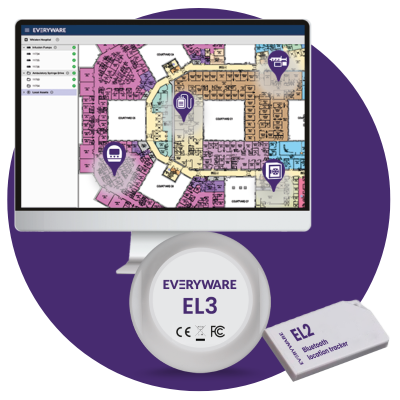Real-Time Location Solutions (RTLS) allow you to digitally track objects and people inside large buildings. They may use Bluetooth, other radio technologies such as UWB, or the WiFi network to do this, or a combination of multiple technologies. RTLS usually involve wireless tags placed on the objects that need tracking, and may also integrate smart devices such as mobile phones to provide additional data.
RTLS are particularly useful indoors, where GPS doesn’t generally work well. That’s why RTLS is a popular choice for tracking assets in hospitals and other healthcare settings.
The way RTLS work can vary greatly. The EVERYWARE system focuses combining the best of modern technologies available, and relies on a network of receivers and active asset tags to accurately locate equipment across the entirety of a hospital.
The physical tags used in RTLS can rely on a range of radio frequency communications. The different options available can feel like a minefield to understand and navigate. This is where EVERYWARE can help: with our extensive knowledge and experience deploying RTLS into the NHS, we can help guide you on choosing the right technology.
Bluetooth Low Energy (BLE) is a wireless technology renowned for its low power usage, cost-effectiveness, and easy setup. It’s widely found in devices like smartphones and IoT devices. BLE is favoured for indoor positioning and RTLS due to its ability to track Bluetooth devices accurately. It uses BLE-enabled sensors or beacons to locate devices like tracking tags within indoor spaces. This technology offers extended battery life for tags compared to traditional Wi-Fi tags, reducing maintenance needs. In essence, BLE is a power-efficient wireless solution for precise indoor tracking and asset management.
Not within the EVERYWARE system. Instead, we can create an independent ultra-low power mesh network via battery-powered wireless receivers placed around the hospital. This acts like a WiFi network and, in many cases, can provide greater tracking accuracy. Another bonus is the ability to address usually dead spots in the hospital that may not have been covered by WiFI historically.
RFID and RTLS solve very different problems, with only limited overlap. The tag cost is very different, with passive RFID tags being lower cost. The infrastructure cost (RFID readers and RTLS receivers) is also very different, with the RTLS infrastructure again costing less. Furthermore, passive RFID tags don’t require a battery.
However, passive RFID tags can’t be used for real-time tracking, as they don’t constantly transmit a signal: their location is only known when triggered by the RFID reader.
For this reason, a combination of these technologies can often be the best solution for tracking a variety of different healthcare assets with different requirements.

Share your details and a member of our team will be in touch to provide a quote and information about our free demo.
Email: info@everyware.co.uk
Head Office
Chandos Business Centre, 87A Warwick Street, Leamington Spa, Warwickshire, CV32 4RJ, United Kingdom